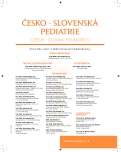Primary (autoimmune) sclerosing cholangitis in patient with inflammatory bowel disease
Authors:
Ľ. Podracká; A. Šuláková
Authors‘ workplace:
Klinika dětského lékařství, Fakultní nemocnice Ostrava-Poruba
přednosta doc. MUDr. M. Hladík, Ph. D.
Published in:
Čes-slov Pediat 2015; 70 (6): 329-332.
Category:
Case Report
Overview
Primary sclerosing cholangitis (PSC) is a chronic cholestatic disease caused by inflammation and fibrosis of the intra and//or extrahepatic bile ducts and can ultimately progress to biliary cirrhosis and hepatic failure. Incidence and prevalence of PSC in children is not exactly know, the 0.23 per 100,000 patients, which is about 5 times less than in adults. The disease is in 85% of causes associated with the inflammatory bowel disease (IBD). In the case that the primary sclerosing cholangitis is associated with an autoimmune presentation, it is necessary to think of overlapping syndrome by AIH/PSC (autoimmune hepatitis), it means sclerosing autoimmune cholangitis (ASC). Major diagnostic method is cholangiography (magnetic resonance cholangiopancreatography) and liver histology.
We present a case of a 13-year-old boy examinated for hepatopathy. The elevation of the ALP, GMT, abnormal imunoglobulin lewels and the presence of anti-neutrophil cytoplasmic antibodies (ANCA) have led to suspicions on the PSC. Liver biopsy confirmed the simultaneous presence of autoimmune inflammation and led to the diagnosis of overlapping syndrome (autoimmune sclerosing cholangitis). During kolonoscopy was found inflammatory of the cecum and Bauhin´s valve and during magnetic resonance enterography (MRE) was found inflammatory od the aboral part of terminal ileum that was histologically confirmed.
Key words:
primary sclerosing cholangitis, overlapping syndrome, inflammatory bowel disease, cholestasis
Sources
1. Sokol H, Cosnes J, Chazouilleres O, et al. Disease activity and cancer risk in inflammatory bowel disease associated with primary sclerosing cholangitis. World J Gastroenterol 2008; 14 (22): 3497–3503.
2. Kaplan GG, Laupland KB, Butzner D, et al. The burden of large and small duct primary sclerosing cholangitis in adults and children: a population-based analysis. AM J Gastroenterol 2007; 102 : 1042–1049.
3. Gregorio GV, Portmann B, Karani J, et al. Autoimmune hepatitis/sclerosing cholangitis overlap syndrome in childhood: a 16-year prospective study. Hepatology 2001; 33 : 544–553.
4. Nevoral J, a kol. Praktická pediatrická gastroenterologie, hepatologie a výživa. 1. vyd. Praha: Mladá fronta, 2013 : 366–367.
5. Boonstra K, Weersma RK, van Erpecum KJ, et al. Population-based epidemiology, malignancy risk, and outcome of primary sclerosing cholangitis. Hepatology 2013; 58 (6): 2045–2055.
6. Feldstein AE Perrault J, EL-Youssif, et al. Primary sclerosing cholangitis in children: a long-term follow-up study. Hepatology 2003; 38 : 210–217.
7. Miloh T, Arnon R, Shneider B, et al. A retrospective single-center rewiev of primary sclerosing cholangitis in children. Clin Gastroenterol Hepatol 2009; 7 : 239–245.
8. Schaeffer DF, Win LL, Hafezi-Bakhtiari S, et al. The phenotypic expression of inflammatory bowel disease in patiens with primary sclerosing cholangitis differs in the distribution of colitis. Dig Dis Sci 2013; 58 (9): 2608–2614.
9. Boonstra K, van Erpecum KJ, van Nieuwkerk KM, et al. Primary sclerosing cholangitis is associated with a distinct phenotype of inflammatory bowel disease. Inflamm Bowel Dis 2012; 18 (12): 2270–2276.
10. Lamberts LE, Janse M, Haagsma EB, et al. Immune-mediated diseases in primary sclerosing cholangitis. Dig Liver Dis 2011; 43 (10): 802–806.
11. Alvarez F. Autoimmune hepatitis and primary sclerosing cholangitis. Clin Liver Dis 2006;10 : 89–107.
12. Takikawa H, Takamori Y, Tanaka A, et al. Analysis of 388 cases of primary sclerosing cholangitis in Japan; presence of subgroup without pancreatic involvement in older patients. Hepatol Res 2004; 29 (3): 153–159.
13. Vergani D, Alvarez F, Bianchi FB, et al. Liver autoimmune serology of the International Autoimmune Hepatitis Group. J Hepatol 2004; 41 : 677–683.
14. Tipnis NA, Dua KS, Welin SL. A retrospective assessment of magnetic resonance cholangiopankreatography in children. J Pediatr Gastroenterol Nutr 2008; 46 : 59–64.
15. Pallavicino F, Pellicano R, Reggiani S, et al. Inflammatory bowel diseases and primary sclerosing cholangitis: hepatic and pancreatic side effects due to azathioprine. Eur Rev Med Pharmacol Sci 2013; 17 (1): 84–87.
16. Rojas-Feria M, Castro M, Suárez E, et al. Hepatobiliary manifestations in inflammatory bowel disease: the gut, the drugs and the liver. World J Gastroenterol 2013; 19 (42): 7327–7340.
17. Lindor KD, Kowdley KV, Luketic VA, et al. High-dose ursodeoxycholic acid for the treatment of primary sclerosing cholangitis. Hepatology 2009; 50 : 808–814.
18. Tung BY, Emond MJ, Haggitt RC, et al. Ursodiol use is associated with lower prevalence of colonic neoplasia in patients with ulcerative colitis and primary sclerosing cholangitis. Ann Intern Med 2001; 134 (2): 89–95.
19. Batta AK, Salen G, Holubec H, et al. Enrichment of the more hydrophilic bile acid ursodeoxycholic acid in the fial water-soluble fraction after feeding to rats with colon polyps. Cancer Res 1998; 58 (8): 1684–1687.
20. Marelli L, Xirouchakis E, Kalambokis G, et al. Does the severity of primary sclerosing cholangitis influence the clinical course of associated ulcerative colitis? Gut 2011; 60 (9): 1224–1228.
21. Drastich P, Bajer L, Wohl P, et al. Transplantace jater pro primární sklerozující cholangitidu. Gastroent Hepatol 2013; 67 (5): 413–420.
22. Horák J, Vaňásek T. PBC (primární biliární cirhóza), PSC (primární sklerozující cholangoitida). Doporučený postup České hepatologické společnosti ČLS JEP. 2010, www.ces-hep.cz.
Labels
Neonatology Paediatrics General practitioner for children and adolescentsArticle was published in
Czech-Slovak Pediatrics

2015 Issue 6
- What Effect Can Be Expected from Limosilactobacillus reuteri in Mucositis and Peri-Implantitis?
- The Importance of Limosilactobacillus reuteri in Administration to Diabetics with Gingivitis
Most read in this issue
- Primary (autoimmune) sclerosing cholangitis in patient with inflammatory bowel disease
- Nicotine alters brain development
- Influence of heel valgus on foot motion during walking in children aged 3–8 years
- Aspergillus fumigatus and cystic fibrosis lung disease – the overview
